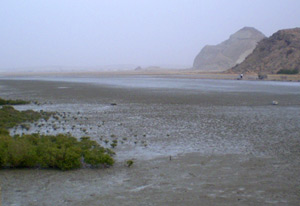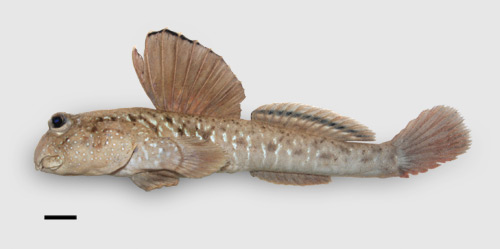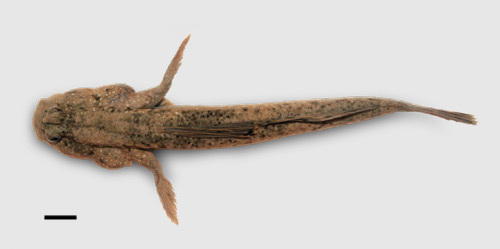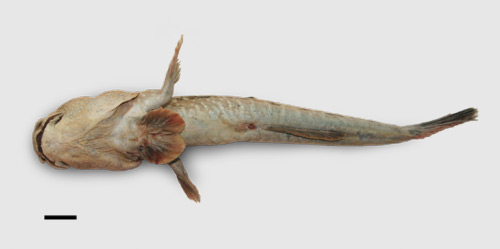Common names:
China |
Chinese, Chinese Mandarin |
澳氏弹涂鱼, 澳氏彈塗魚 (Ao shi tan tu yu - Ao's mudskipper) |
Iran |
Farsi (Persian)
|
gel khorok, gel-cheragh (= mud-eater, mud-grazer), mahi-sag (= dog-fish) |
Iraq |
Arabic |
shelambo, abou-shlembo, abu-shelamboo |
Italy |
Italian |
perioftalmo di Walton* |
Pakistan |
Urdu |
gullo |
United Kingdom |
English |
Walton's mudskipper, dark-blotched mudskipper |
* proposed name
|
|
|
Synonyms:
Periophthalmus waltoni |
Koumans, 1941 |
(senior synonym, original combination)
|
Etymology:
'Periophthalmus' is a compound name from the Greek 'peri' (around), and 'ophthalmôn' (eye), which refers to the wide visual field of these species
the species is named after H.J. Walton, who collected the material for the original
description (Murdy, 1989)
|
Maximum recorded length:
123 mm SL (Murdy, 1989)
176 mm TL (Abdoli et al., 2009)
Live colouration (Murdy, 1989;
pers. obs.: Iran):
ground colour grey to slate; sometimes remnants of white spots on head; large dark blotches and vertical silvery bars on flanks of some specimens;
dorsal dark blotches in some specimens; D1 grey with a black margin anteriorly; four stripes on D2 from margin to base: grey, black, white, grey;
caudal and anal fins grey; pelvic fins dark; pectoral fins grey: in some specimens, the curved brown stripe is visible
Colouration on preservation (Murdy, 1989;
pers. obs.: Iran, Kuwait):
ground colour grey to slate; sometimes remnants of white spots on head; large dark blotches and vertical silvery bars on flanks of some specimens;
dorsal dark blotches in some specimens; D1 grey with a black margin anteriorly; four stripes on D2 from margin to base: grey, black, white, grey;
caudal and anal fins grey; pelvic fins dark; pectoral fins grey: in some specimens, the curved brown stripe is visible
Diagnosis (Murdy, 1989):
D1 X-XIII; longitudinal scale count 91-121; total D2 elements 13-14; total anal fin elements 11-12; TRDB 21-28; head width 13.7-21.9%SL; pelvic fin length
11.8-13.9%SL; length of anal fin
base 16.2-21.0%SL; length of D2 base 23.2-27.2%SL; moderate to strong pelvic frenum, with pelvic inner rays fused by a basal membrane for about one half of
their length; no stripe or spot on fin, with the
exception of few spots on its proximal and posterior portion in some specimens; no elongated spines; D2 with a single inframarginal dark stripe; dorsal
fins not connected by membrane.
The genus is yet undefined by synapomorphies
Diet:
carnivorous and opportunistic, feeding on small animals such as insects, worms, crustaceans and fish
(Barak et al., 1994;
Clayton & Snowden, 2000;
Mhaisen & Al-Maliki, 1996)
Reproduction:
no published study is available
|
|
Ecological notes (Polgar et al., 2009):
locally very abundant on open mudflats and nearby stunted mangroves in the Persian Gulf.
Morphometric differences between samples of this species from the Persian Gulf, Strait of Hormuz and Gulf of Oman relate to different physico-chemical conditions of surface waters in these areas, suggesting the presence of phenotypically plastic responses to temperature or salinity, or both (Ghambarifardi et al., 2014).
left: typical habitat of Periophthalmus waltoni
(photo: G. Polgar, Qeshm Island, Iran, 2007)
|

|
|
|
Distribution:
Persian Gulf to the west coast of India (= Periophthalmodon septemradiatus sensu Bhatt et al., 2009; Gujarat, Gulf of Kutch); type locality: Iraq and Pakistan (Murdy, 1989)
|
Remarks:
this species is consumed by local fishermen, who easily catch them by hand-nets or even with bare hands
(pers obs.). Nonetheless, Islamic rules would usually prohibit to eat amphibious animals. Some cultures
believe that eating mudskippers could heal malaria fever
|
Photographs of Periophthalmus waltoni:
|
A: a preserved specimen of P. waltoni (5% formalin) from Khor Subiyah, Kuwait; B: an
adult nearby its burrow; C:
close-up; D: another close-up: feeding; E: close-up of the head of a preserved specimen (37% formalin) from Bandar Abbas, Iran;
F, G: specimens from Bandar Abbas, Iran, into a tank (photos A-G: G. Polgar, 2007);
H: another close up (photo: J. Bishop, Kuwait, 2006)*; I: an individual inside its burrow (photo: L. Abdoli, Hormozgan, Iran 2007)*; J: aggressive encounter (photo: Muhammad Hussain, northern Kuwait, 2007)* - * with permission
|
Drawings of Periophthalmus waltoni:
left: cephalic sensory and nasal pores of Periophthalmus spp.: an= anterior nostril; pn= posterior nostril (modified from
Murdy, 1989)*; right: drawing by Susan Laurie-Bourque, from Coad, 2007* - * with permission
|







